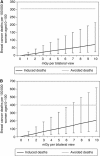Population-based mammography screening below age 50: balancing radiation-induced vs prevented breast cancer deaths
- PMID: 21364575
- PMCID: PMC3068504
- DOI: 10.1038/bjc.2011.67
Population-based mammography screening below age 50: balancing radiation-induced vs prevented breast cancer deaths
Abstract
Introduction: Exposure to ionizing radiation at mammography screening may cause breast cancer. Because the radiation risk increases with lower exposure age, advancing the lower age limit may affect the balance between screening benefits and risks. The present study explores the benefit-risk ratio of screening before age 50.
Methods: The benefits of biennial mammography screening, starting at various ages between 40 and 50, and continuing up to age 74 were examined using micro-simulation. In contrast with previous studies that commonly used excess relative risk models, we assessed the radiation risks using the latest BEIR-VII excess absolute rate exposure-risk model.
Results: The estimated radiation risk is lower than previously assessed. At a mean glandular dose of 1.3 mGy per view that was recently measured in the Netherlands, biennial mammography screening between age 50 and 74 was predicted to induce 1.6 breast cancer deaths per 100,000 women aged 0-100 (range 1.3-6.3 extra deaths at a glandular dose of 1-5 mGy per view), against 1121 avoided deaths in this population. Advancing the lower age limit for screening to include women aged 40-74 was predicted to induce 3.7 breast cancer deaths per 100,000 women aged 0-100 (range 2.9-14.4) at biennial screening, but would also prevent 1302 deaths.
Conclusion: The benefits of mammography screening between age 40 and 74 were predicted to outweigh the radiation risks.
Figures

References
-
- Adami HO, Malker B, Holmberg L, Persson I, Stone B (1986) The relation between survival and age at diagnosis in breast cancer. N Engl J Med 315(9): 559–563 - PubMed
-
- Beemsterboer PM, Warmerdam PG, Boer R, de Koning HJ (1998) Radiation risk of mammography related to benefit in screening programmes: a favourable balance? J Med Screen 5(2): 81–87 - PubMed
-
- Bjurstam N, Bjorneld L, Warwick J, Sala E, Duffy SW, Nystrom L, Walker N, Cahlin E, Eriksson O, Hafstrom LO, Lingaas H, Mattsson J, Persson S, Rudenstam CM, Salander H, Save-Soderbergh J, Wahlin T (2003) The Gothenburg Breast Screening Trial. Cancer 97(10): 2387–2396 - PubMed
Publication types
MeSH terms
LinkOut - more resources
Full Text Sources
Medical

